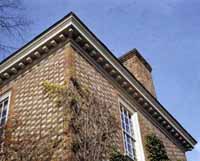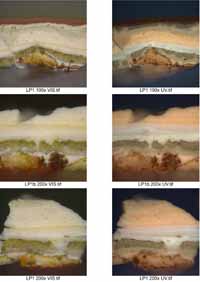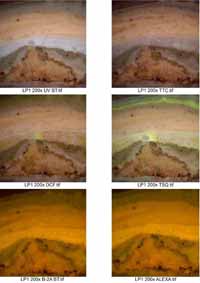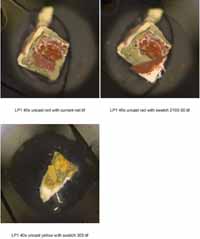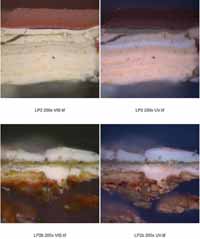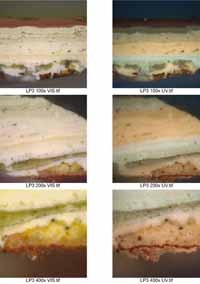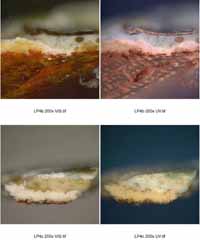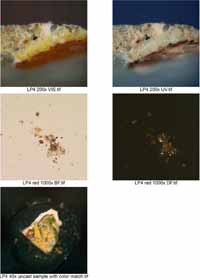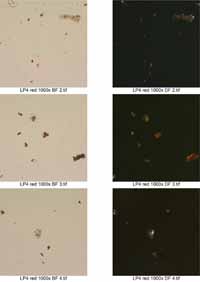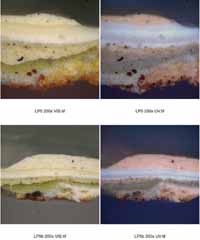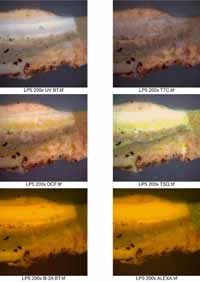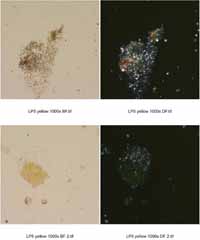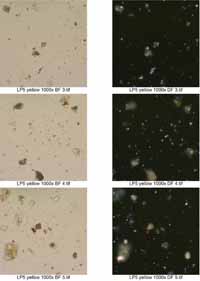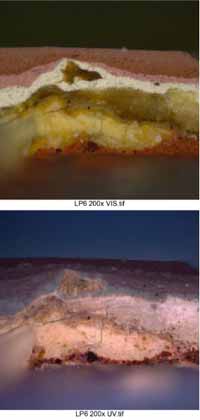Cross-Section Microscopy Analysis of Exterior Paints, Ludwell-Paradise House (Block 18, Building 7)
Colonial Williamsburg Foundation Library
Research Report Series - 1732
Colonial Williamsburg Foundation
Library
Williamsburg, Virginia
2012
Cross-Section Microscopy Analysis of Exterior Paints, Ludwell-Paradise House (Block 18, Building 7)
Table of Contents
| Purpose | 1 |
| Previous Research | 1 |
| Historical Background | 1 |
| Sampling Procedures | 3 |
| Sampling Locations | 3 |
| Results of Cross-Section Microscopy Analysis | 3 |
| Results of Pigment Identification with Polarized Light Microscopy | 10 |
| Results of Binding Media Analysis with Fluorochrome Stains | 13 |
| Results of Colorimetry | 20 |
| Conclusion | 22 |
| Appendix | |
| Sampling Memorandum | 23 |
| Cross-Section Preparation Procedures | 24 |
| Colorimetry Data | 26 |
| Contact Sheets of Cross-Section Photomicrographs | 27 |
Cross-Section Microscopy Analysis of Exterior Finishes
| Structure: | Ludwell-Paradise House, Colonial Williamsburg Foundation |
|---|---|
| Requested by: | Edward A. Chappell, Director, Architectural Research Department |
| Conservator: | Natasha K. Loeblich, Architectural Paint Analyst, Architectural Research Dept. |
| Consultant: | Susan L. Buck, Ph.D., Conservator and Paint Analyst |
| Date: | October 2008 |
Purpose
The goal of this project is to identify the color and composition of the early finishes, if they are present, in six samples from the main cornice of the Ludwell-Paradise House. A variety of techniques are used, including cross-section microscopy with reflected visible and ultraviolet light, pigment identification with polarized light microscopy, binder identification with fluorochrome staining, and colorimetry.
Previous Research
According to Chappell, paint analyst Frank S. Welsh undertook an examination of the exterior paint on the Ludwell-Paradise House, but his report could not be located. Apparently, he found that the house had been originally painted with a red-brown paint. This color was matched to create the red-brown paint currently being applied to the house.
Historical Background
The Ludwell-Paradise House was most likely built by Phillip Ludwell III in the early 1750s. By 1755, he was advertising this house, "a very good Dwelling-House", for rent in the Virginia Gazette.1 In 1767 he died and the house passed to his daughters and their husbands. The house apparently remained a rental property and in January 21, 1771, Phillip Ludwell Lee writes to William Lee that "Yr houses in Wmsbg are in bad repair always rented to bad tenants always nasty & few rents paid."2 This suggests that the house might not have been repainted very often up to this point. In March 7, 1771, William Lee writes back "then add the rents of the houses in Wmsbg. deductg 10 p6 [sic] for repairs". This second letter suggests that the house might have been repainted in 1771 as part of routine repairs. The house remained a rental property for several years until Lucy Ludwell Paradise began occupying the house in 1805.
The Ludwell-Paradise House was the first building bought by John D. Rockefeller, Jr., for what would be Colonial Williamsburg in 1926. Before the house was acquired, several restorations had replaced most of the exterior elements except for the cornice. The interior seems to have been modernized around 1850, the south door frontispiece was replaced in the early 1920s, and the windows were lengthened, shortened and then replaced in different building campaigns.3 Colonial Williamsburg undertook a restoration in 1931 in which they either created new elements as needed, or reused elements from other eighteenth- 2 century structures.4 For example, the north wall of the shed was recovered with weatherboards from an old house in Norfolk. All the upper windows were decayed and were replaced with copies during the 1931 restoration. The report notes that "the first floor windows, entrances, and porches, north wall and openings in east and west walls, roof and cornice cyma, chimneys had been altered from time to time, more particularly by the College of William and Mary a few years ago." The report states that the main cornice, which may be the only original woodwork on the exterior, was patched during the restoration.
Original cornice [was] practically intact except for cyma mold… This was replaced with a typical local type as evidenced in this sort of cornice with modillions: i.e., "Apothecary Shop" just east of Paradise House. This was made new by heart yellow pine. Where necessary at various places—original cornice was patched and repaired…. Other than cornice cyma, window frames, sash, trim and first floor basement window openings—front door and steps—and certain patching and roofing—and brick of chimneys—this elevation is now as it was in the eighteenth century.5
The report comments that on the north elevation, "the shed cornice mold is a crown mold from 'Springfield Farm,' New Kent County, Virginia. The back board (beaded) is from same source as weatherboards. With bead run by hand to architects' detail." The restoration report also explains that the new paint colors applied to the building following the restoration were chosen based on a selection of period colors that were found locally. The report gives color numbers for the exterior paints:
Colors referred to below are designated by a number which indicates a sample on paint sample board in keeping of architects. These are authentic 17th century colors—gathered with aid of several authorities and checked by actual ancient colors of the period found locally.
Exterior:
6
Trim - #91-S.
Body (North Elevation) - #97-S.
Front and Back Doors - #88-S.
North Blinds - #139-S
These numbers do not correspond to sample boards currently held by the Colonial Williamsburg Paint Shop. The earliest color records held by the Paint Shop date to May 24, 1951. They specify:
Body - 167 Grayish Green
Trim - 163 Similar to Market Square Tavern Shell
Doors - 187 Same as Market Square Tavern Dark Green
Blinds - 187 Same as Market Square Tavern Dark Green
Porch Floor & Steps - 25 Same as Raleigh Tavern Sorrel7
The sample boards corresponding to these numbers are medium gray (#167), off-white (#163), greenblack (#187), and yellow-brown (#25). Thus it appears that since the 1950s at least, the trim on the house has been painted cream with the door and shutters dark green. The porch floor a yellow-brown and the rear siding a medium gray.
Sampling Procedures
On October 29, 2007, the author took six samples from the cornice of the Ludwell-Paradise House. The house was being reshingled and the necessary scaffolding allowed access to the cornice. Three samples were removed from the main cornice on the north elevation and three from the front elevation on the south. The crown molding appeared to have been replaced so it was not sampled.
Sampling Locations
| Sample # | Location |
|---|---|
| LP1 | North elevation cornice, cymatium above lower fascia between 27th and 28th modillion block from west end |
| LP2 | North elevation cornice, lower fascia between 27th and 28th modillion block from west end, top edge just below cymatium |
| LP3 | North elevation cornice, east side of 27th modillion block from west end, top edge just below cymatium |
| LP4 | South elevation, top edge of large quarter round of bed molding just below lower fascia, between 23rd and 24th modillion block from east |
| LP5 | South elevation, top of lower fascia, between 23rd and 24th modillion block from east |
| LP6 | South elevation, west side of 23rd modillion block from east just below cymatium |
Results of Cross-Section Microscopy Analysis
All the samples taken from the cornice of the Ludwell-Paradise House had evidence of the same early finish layers which are presented in the table to the right. This suggests that much of the original cornice is still intact. The cross-sections from the samples indicate that the wood was first treated with a resinous coating. Generation 1 was a red-brown paint that was found in all the samples. Generations 2 and 3 were both dull yellow paints. The first three generations have large pigment clumps which suggests they are hand-ground, consistent with eighteenth-century paints. Generations 4 and 6 were white paints and generation 5 was a thick cream-colored paint. Generation 7 was a blue-gray paint that probably dates to after 1845. Generation 8 was a dull green paint and generation 9 was a light brown paint with large black pigments. Generations 10 through 21 were white paints, indicating that for a long period of time the trim on the house was probably painted white. The last three generations of paint were red-brown in color and probably represent paint applied after Welsh finished his study of the early paints on the cornice.
| Generation | Paint on Cornice |
|---|---|
| 22-24 | modern red-brown |
| 21 | modern white |
| 10-20 | white |
| 9 | light brown |
| 8 | dull green |
| 7 | blue-gray |
| 6 | white |
| 5 | cream |
| 4 | white |
| 3 | dull yellow |
| 2 | dull yellow |
| 1 | red-brown |
| Substrate | wood with resinous sealant |
The photomicrograph below has evidence of the resin applied to the wood before application of the first-generation of red-brown paint. This was probably a sealant added to prepare the wood for painting. The resinous material has an orange fluorescence that is characteristic of shellac, but this will need to be confirmed with analytical testing.
The first paint layer was a red-brown paint with very little autofluorescence, which suggests it has an oil binder. The paint is thin and uneven, probably from wear and weathering, and there are particles of dirt above it indicating that it was a presentation surface for some time (see page 8). It is possible that this finish was applied to the cornice after construction in early 1750s and not painted over for some time.
The red-brown paint must have become somewhat chalky because red pigments were picked up in the bottom of the next layer when it was applied. The original red-brown paint was either leanly bound or allowed to weather until the binder was almost fully leached away.
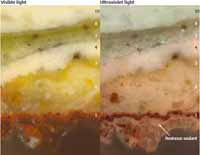 Sample LP3, north elevation cornice, east side of 27th modillion block from west end, top edge just below cymatium, 400x magnification
Sample LP3, north elevation cornice, east side of 27th modillion block from west end, top edge just below cymatium, 400x magnification
The second generation of paint was a dull yellow in color with large clumps of yellow ochre pigment. The coarse nature of this paint suggests it was hand-ground, consistent with eighteenth-century paint. The dull yellow paint was also allowed to sit on the surface for sometime as there is dirt collected on its surface (see page 6). This paint might have been applied in 1767 when the house changed hands, or it may have been applied after March of 1771 when William Lee ordered repairs be done on the house.
Samples LP1, LP2, and LP3 from the north cornice had evidence of a second dull yellow paint layer. There is a definite boundary between the two dull yellow paints so the second application of dull yellow paint counts as the third generation of finish. Oddly, the front cornice on the south elevation does not have evidence of the second dull yellow paint. Perhaps the rear rooms made the north cornice more accessible and it was repainted more frequently, or the south cornice weathered more significantly and evidence of some of the paint layers was lost. There is grime above the dull yellow paint of generation 3 indicating that it was exposed for a significant period of time.
Generation 4 is a white paint with a pinkish autofluorescence that is typical of an aged oil paint. This layer is probably pigmented with lead white pigment and does not appear to have any other colored pigments. There is an accumulation of grime over this paint, and the layer is discontinuous in most samples, so this paint must have been allowed to weather significantly. Perhaps this paint was applied when Lucy Ludwell Paradise moved into the house in 1805 and might have wanted to modernize with a more classical white paint.
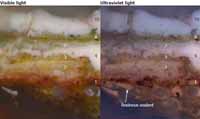 Sample LP2, north elevation cornice, lower fascia between 27th and 28th modillion block from west end, top edge just below cymatium, 200x magnification
Sample LP2, north elevation cornice, lower fascia between 27th and 28th modillion block from west end, top edge just below cymatium, 200x magnification
Generations 5 and 6 were only found in one sample (LP4) from a protected location on the front cornice. Generation 5 was a thick cream-colored paint with a bright bluish fluorescence. This layer is somewhat translucent, but is too opaque and thick to be a limewash. Instead, it may have a proteinaceous or resinous component. It might be a putty or a fill material, or even a waterproofing material applied to selected locations. Generation 6 was a second cream-colored paint with a pinkish autofluorescence in reflected ultraviolet light. It has a similar appearance to generation 4 and both paints probably contain lead white in an oil binder.
 Sample LP4, south elevation, top edge of large quarter round of bed molding just below lower fascia, between 23rd and 24th modillion block from east, 200x magnification
Sample LP4, south elevation, top edge of large quarter round of bed molding just below lower fascia, between 23rd and 24th modillion block from east, 200x magnification
Generation 7 and 8 were the first layers that stained positive for zinc when the fluorochrome stain TSQ was applied. The zinc is likely present as zinc white pigment which was not available for use in oil paint until 1845.8 Therefore these layers must postdate this. Generation 7 was a blue-gray paint with fine blue and black particles. Generation 8 was a dull green paint with yellow and black pigments. The two paints appear to have had similar compositions and there was not much dirt separating them so they were probably applied fairly close in time to each other. Generation 9 was a coarse, light brown paint that was only found in sample LP5. This paint had large black pigments and yellow pigments and a muted autofluorescence under reflected ultraviolet light.
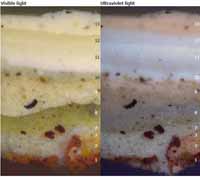 Sample LP5, south elevation, top of lower fascia, between 23rd and 24th modillion block from east, 200x magnification
Sample LP5, south elevation, top of lower fascia, between 23rd and 24th modillion block from east, 200x magnification
Generations 10, 11, and 12 were white paints with a bright bluish fluorescence. Generations 10 and 11 seem to have had similar compositions and almost seem to blend together, as if they were applied at the same time. However, in a few images there are particles of grime trapped between the two layers that indicate that they were not applied at exactly the same time. Generations 13 through 18 were white paints with pinkish fluorescence. There are faint traces of grime between these layers as well.
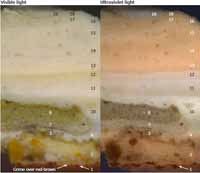 Sample LP1, north elevation cornice, cymatium above lower fascia between 27th and 28th modillion block from west end, 200x magnification
Sample LP1, north elevation cornice, cymatium above lower fascia between 27th and 28th modillion block from west end, 200x magnification
Generations 19 and 20 were white paints, the first with a bright bluish fluorescence and the second with a yellowish fluorescence. Generation 21 was composed of a modern white paint with a primer and a finish coat. Generation 22, 23, and 24 were modern red-brown paints with primers and finish coats. The red-brown paints must have been applied after Welsh's paint analysis report in which he found that the cornice had originally been painted red-brown. All the modern paints were finely ground and have almost no fluorescence, suggesting they have synthetic binders.
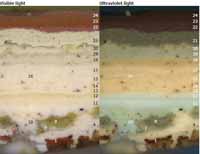 Sample LP3, north elevation cornice, east side of 27th modillion block from west end, top edge just below cymatium, 100x magnification
Sample LP3, north elevation cornice, east side of 27th modillion block from west end, top edge just below cymatium, 100x magnification
Results of Pigment Identification with Polarized Light Microscopy
Dispersed pigments from the first-generation red-brown paint in Sample LP4 were examined with polarized light microscopy to determine the pigment composition. The red-brown paint was found to contain an iron oxide red pigment (possibly red ochre or Spanish brown), chalk (calcium carbonate is a common paint extender), yellow ochre, lamp black, and lead white. It is not possible to be sure that the yellow ochre pigment was not a contaminant from the generation 2 dull yellow paint. All of the pigments detected in the red-brown paint were common, relatively inexpensive pigments that were readily available in the eighteenth century.
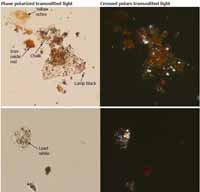 Sample LP4, generation 1 red-brown paint from south elevation, top edge of large quarter round of bed molding just below lower fascia, between 23rd and 24th modillion block from east, dispersed pigment sample, 1000x magnification
Sample LP4, generation 1 red-brown paint from south elevation, top edge of large quarter round of bed molding just below lower fascia, between 23rd and 24th modillion block from east, dispersed pigment sample, 1000x magnification
Dispersed pigments from the second-generation dull yellow paint in Sample LP5 were also examined with polarized light microscopy. The dull yellow paint was found to contain yellow ochre (including geothite, a naturally occurring mineral often found with yellow ochre), chalk, an iron oxide red, and lead white. It is not possible to be sure that the iron oxide red pigment is not a contaminant from the generation 1 red-brown paint. All three of the pigments detected in the dull yellow paint are common, relatively inexpensive pigments that were readily available in the eighteenth century.
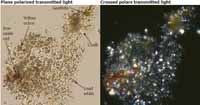 Sample LP5, generation 2 dull yellow paint from south elevation, top of lower fascia, between 23rd and 24th modillion block from east, dispersed pigment sample, 1000x magnification
Sample LP5, generation 2 dull yellow paint from south elevation, top of lower fascia, between 23rd and 24th modillion block from east, dispersed pigment sample, 1000x magnification
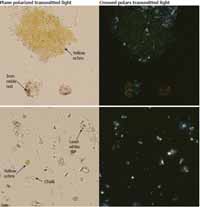 Sample LP5, generation 2 dull yellow paint from south elevation, top of lower fascia, between 23rd and 24th modillion block from east, dispersed pigment sample, 1000x magnification
Sample LP5, generation 2 dull yellow paint from south elevation, top of lower fascia, between 23rd and 24th modillion block from east, dispersed pigment sample, 1000x magnification
Results of Binding Media Analysis with Fluorochrome Stains
Two samples (LP1 and LP5) with early paint layers were chosen for binding media analysis. The crosssections were treated with biological fluorochrome stains that react with proteins, carbohydrates, oils, and zinc (Zn2+) in the individual layers. When TTC, a fluorochrome stain that marks out carbohydrates with a dark red positive reaction color, was applied several of the layers reacted positively for carbohydrates becoming more red. The first generation red-brown paint was already red so it may be masking a positive reaction. All the other early layers reacted weakly positive for carbohydrates suggesting that the paints may have a starch or natural gum component. Period recipes sometimes call for the addition of a natural plant gum when grinding pigments into an oil binder to aid in dispersion. More modern emulsion paints often have carbohydrate additions as well.
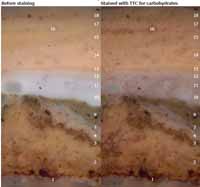 Sample LP1, north elevation cornice, cymatium above lower fascia between 27th and 28th modillion block from west end, ultraviolet light, 200x magnification
Sample LP1, north elevation cornice, cymatium above lower fascia between 27th and 28th modillion block from west end, ultraviolet light, 200x magnification
The photomicrograph below shows the same weak and spotty positive reaction for carbohydrates in the early layers. There is a stronger reaction in some of the more recent layers that suggests they do not have pure oil binders. Some of the later layers may have had a cellulosic bulking agent.
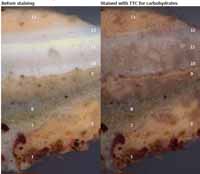 Sample LP5, south elevation, top of lower fascia, between 23rd and 24th modillion block from east, ultraviolet light, 200x magnification
Sample LP5, south elevation, top of lower fascia, between 23rd and 24th modillion block from east, ultraviolet light, 200x magnification
Cross-sections from samples LP1 and LP5 were also stained with the fluorochrome stain Alexafluor 488, which marks out the presence of proteins with a positive green reaction color. Neither sample exhibited a positive reaction for proteins in the early layers, as evidenced by the lack of change between the before and after staining photomicrographs shown below.
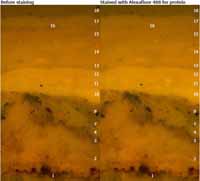 Sample LP1, north elevation cornice, cymatium above lower fascia between 27th and 28th modillion block from west end, B-2A filter cube, 200x magnification
Sample LP1, north elevation cornice, cymatium above lower fascia between 27th and 28th modillion block from west end, B-2A filter cube, 200x magnification
Some of the more recent layers did show a slight positive reaction for proteins. In the cross-section below the white paint was generation 10 became brighter after staining and the modern white paint of generation 21 showed clear pockets of a positive green reaction color. Both of these paints may be emulsion paints made with protein and oil components.
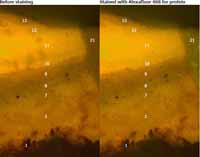 Sample LP5, south elevation, top of lower fascia, between 23rd and 24th modillion block from east, B-2A filter cube, 200x magnification
Sample LP5, south elevation, top of lower fascia, between 23rd and 24th modillion block from east, B-2A filter cube, 200x magnification
The cross-sections were also stained with the fluorochrome stain DCF that marks out the presence of aged oils (saturated lipids) with a pink positive reaction color and less aged oils (unsaturated lipids) with a yellow reaction color. The generation 1 red-brown paint might have reacted positively for oils, but the red color of the paint might be disguising the reaction color. The paints in generations 2 through 18 showed a slight positive pink reaction color for aged oils.
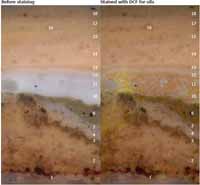 Sample LP1, north elevation cornice, cymatium above lower fascia between 27th and 28th modillion block from west end, ultraviolet light, 200x magnification
Sample LP1, north elevation cornice, cymatium above lower fascia between 27th and 28th modillion block from west end, ultraviolet light, 200x magnification
Sample LP5 had a similar reaction when the fluorochrome stain DCF was applied. Generations 2 through 9 reacted positively for aged oils with a pink reaction color. Generations 7 and 8 and 10 through 13 in this sample showed a pink reaction color, as well as a yellow positive reaction color for less aged oils.
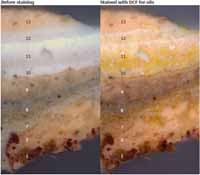 Sample LP5, south elevation, top of lower fascia, between 23rd and 24th modillion block from east, ultraviolet light, 200x magnification
Sample LP5, south elevation, top of lower fascia, between 23rd and 24th modillion block from east, ultraviolet light, 200x magnification
When the fluorochrome stain TSQ was applied to both samples the blue-gray paint in generation 7 was the first paint to react positively for zinc (Zn2+) with a bright blue reaction color. The dull green paint in generation 8 and the three white paints in generations 10 through 12 also showed positive reactions for zinc. The zinc is probably present as zinc white, a pigment that was not available for use in oil paint until after 1845. Thus, generation 7 could not have been applied before 1845. This indicates that on average the cornice was only repainted every 15 years or so.
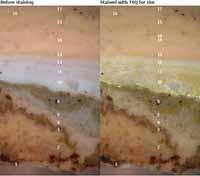 Sample LP1, north elevation cornice, cymatium above lower fascia between 27th and 28th modillion block from west end, ultraviolet light, 200x magnification
Sample LP1, north elevation cornice, cymatium above lower fascia between 27th and 28th modillion block from west end, ultraviolet light, 200x magnification
Results of Colorimetry
Color measurements were undertaken for this report from cornice samples LP1, LP4, and LP5, and LP6. Five measurements were taken from uncast samples (LP1 and LP5) with large portions of the original generation 1 red-brown paint. The color of the red-brown paint is variable due to the coarseness of the hand-ground paint. To get the most accurate measurement, all the color measurements from each color were averaged to find the one measurement that was closest to the average. This measurement was from sample LP1 and had an L* value of 38.07, an a* value of +14.53, and a b* value of +12.17. This paint is different from the average of all the measurements by a Δ value of 1.19. In the Munsell color system the paint had a hue of 9.5R, a value of 3.70, and a chroma of 4.10. Next, the red-brown paint that is the current finish was measured from an uncast portion of sample LP6. This modern paint had an L* value of 36.44, an a* value of +15.69, and a b* value of +11.98 in the CIE L*a*b* color system. The most recently applied red-brown paint is different from the original red-brown paint by a Δ value of 2.01, which is acceptable.
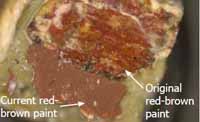 Upside down uncast sample LP1 with generation 1 red-brown paint and current red-brown paint, 40x magnification
Upside down uncast sample LP1 with generation 1 red-brown paint and current red-brown paint, 40x magnification
An attempt was made to find a better match for the original generation 1 red-brown paint. Under magnification with a color-corrected light source, the best commercial paint match found to the first-generation red-brown paint was a swatch of Benjamin Moore 2103-30 "Peatmoss" which has an L* value of 38.03, an a* value of +14.20, and a b* value of +11.77. This commercial paint swatch is different from the color of the first-generation red-brown paint by a low Δ value of 0.52. Thus, this swatch represents a paint color that is a slightly better match for the generation 1 red-brown than the current red-brown pant being used to paint the trim on the house. Since there is no surviving finish history on the other trim elements this color could be used, by extrapolation to repaint the rest of the exterior trim.
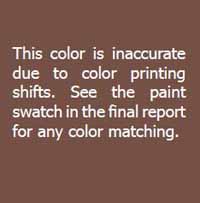 Best commercial paint match to generation 1 red-brown paint, Benjamin Moore 2103-30
Best commercial paint match to generation 1 red-brown paint, Benjamin Moore 2103-30
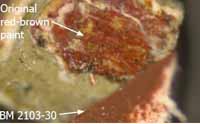 Upside down uncast sample LP1 with generation 1 red-brown paint and color match, 40x magnification
Upside down uncast sample LP1 with generation 1 red-brown paint and color match, 40x magnification
After all the generation 2 dull yellow paint fragments from samples LP4 and LP5 were measured, the closest match to the average was from sample LP4 and had an L* value of 62.28, an a* value of +3.93, and a b* value of +24.31. Like the red-brown paint, the dull yellow paint is somewhat variable in color and this measurement was different from the average by a ΔE value of 0.42. In the Munsell color system this paint had a hue of 0.1Y, value of 5.90, and chroma of 3.50. Under magnification with a color-corrected light source, the best commercial paint match found to the second-generation dull yellow paint was a swatch from the Williamsburg Color Collection CW 303 "James Geddy Tan" which has an L* value of 59.70, an a* value of +3.68, and a b* value of +27.13. This commercial paint swatch is different from the color of the first-generation red-brown paint by a ΔE value of 3.43. The high ΔE value of the paint can be explained by the variability of the paint caused by the large pigment clumps. The commercial paint swatch represents a paint color that is a good match for the dull yellow paint that was applied to the cornice in generation 2. This was most likely the color used on the cornice during the 1774-1781 period of interpretation in the historic area.
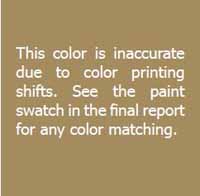 Best commercial paint match to generation 2 dull yellow paint, Williamsburg Color Collection,
Best commercial paint match to generation 2 dull yellow paint, Williamsburg Color Collection,
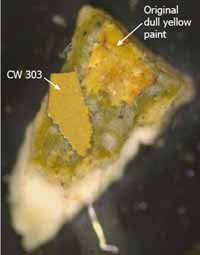 Upside down uncast sample LP1 with generation 2 dull yellow paint and color match, 40x magnification
Upside down uncast sample LP1 with generation 2 dull yellow paint and color match, 40x magnification
Conclusion
All of the six samples taken from the cornice of the Ludwell-Paradise House had evidence of early paints. This is particularly useful since on-site examination and the 1930s restoration report suggest that most other exterior trim has been replaced. Since the cornice may hold the only original exterior paint evidence the color of this element should be extrapolated for the rest of the trim on the house when repainting is done. A color will also have to be chosen for the front door which may not have been painted monochromatically with the rest of the trim.
The cornice samples indicate that the wood was first treated with a resinous material that was probably applied to seal the wood before painting. The material has a orange fluorescence that is characteristic of shellac, but the resin will need to be identified with analytical testing. The first generation of paint was red-brown and probably had an oil binder since it has little fluorescence. However, the red color of the paint masked any positive reactions for aged oils when fluorochrome stains were applied. The paint was found to contain an iron oxide red, lead white, chalk, lamp black, and some yellow ochre that may be a contaminant from a later layer. The red paint is very worn and thin and has some pockets of grime above it indicating that it was a presentation surface that was left to weather on the surface for a significant period of time. After the Ludwell-Paradise House was built in the 1750s it remained a rental property until Lucy Ludwell Paradise occupied it in 1805. In 1767, the house was inherited by the heirs of Philip Ludwell III and in 1771 was recorded as being "in bad repair". It is possible that the red-brown paint remained on the cornice until later in 1771 when the new owner ordered repairs be done. The color of the red-brown paint was measured and a commercial color match was provided, though the red-brown paint currently being used on the house is an acceptable match.
The second generation of paint was a dull yellow in color. This paint was later refreshed with a second coat of an identical color and composition in some areas. Both layers reacted positivly for aged oils and carbohydrates when fluorochrome stains were applied. They are probably oil paints with the addition of a natural gum to aid in the dispersion of the pigments in the binder. The dull yellow layers were pigmented with yellow ochre, brownish geothite, lead white, chalk, and an iron oxide red that is likely a contaminant from the paint below. The first dull yellow paint might have been applied in 1771 when repairs were made to the house. Thus, this paint would probably have been the presentation surface during the 1774-1781 period of interpretation in the historic area. The color of the dull yellow paint was measured and a commercial color match was provided for use when repainting.
The fourth-generation finish was a white paint that appears to be have been colored with lead white and chalk. This paint stained positive for aged oils and carbohydrates with fluorochrome stains were applied. Possibly, this paint was applied in 1805 when Lucy Ludwell Paradise occupied the house and may have wanted to give it an updated, more classical appearance. Generations 5 and 6 were also white or cream-colored paints. Generation 7 was a blue-gray paint that stained positive for zinc, suggesting it was applied after 1845. This would indicate that at most the cornice was only repainted about every 15 years or so. Generation 8 was a dull green paint, that also appears to contain zinc white, and generation 9 was a light brown paint. Generations 10 through 21 were all white paints. Generations 22 through 24 were red-brown paints that must have been applied after Frank S. Welsh did a study of the cornice in the 1980s and discovered that it was first painted red-brown.
Footnotes
Appendix
Sampling Memorandum
From: Natasha loeblich
Date: October 29, 2007
Re: Sampling of Ludwell-Paradise House cornice
Today I took six samples from the Ludwell-Paradise House cornice, three from the north elevation and three from the south, front elevation. The crown molding appeared to have been replaced, but everything else looked original. The samples are as follows:
- 1. LP1 North elevation cornice, cymatium above lower fascia between 27th and 28th modillion block from west end
- 2. LP2 North elevation cornice, lower fascia between 27th and 28th modillion block from west end, top edge just below cymatium
- 3. LP3 North elevation cornice, east side of 27th modillion block from west end, top edge just below cymatium
- 4. LP4 South elevation, top edge of large quarter round of bed molding just below lower fascia, between 23rd and 24th modillion block from east
- 5. LP5 South elevation, top of lower fascia, between 23rd and 24th modillion block from east
- 6.LP6 South elevation, west side of 23rd modillion block from east just below cymatium
Cross-section Preparation Procedures
The samples were initially examined with a stereomicroscope under low power magnification (5 to 50 times magnification) and divided as needed. When possible, a portion of each sample was kept in reserve for future analysis and a portion cast in a labeled cube of a commercial two-part polyester resin manufactured by Excel Technologies, INC. (Enfield, CT). The resin was cured under an incandescent lamp for several hours. The resin cubes were then ground on a motorized grinding wheel with 200 grit sandpaper to reveal the cross-sections. Final finishing was achieved using a Buehler Metaserv 2000 grinder polisher equipped with abrasive cloths from Micro Mesh, INC. with grits of 1500 to 12,000.
Cross-section microscopy analysis was performed using a Nikon Eclipse 80i microscope equipped with an EXFO X-Cite 120 Fluorescence Illumination System fiberoptic halogen light source. The cross-sections were examined at magnifications of 40x, 100x, 200x, and 400x using reflected visible light and a brightfield filter cube. Several fluorescence filter cubes were also used including a UV-2A cube with 330-380nm excitation, a 400nm dichroic mirror, and a 420nm barrier filter, a B-2A cube with a 450-490nm excitation, a 505nm dichroic mirror, and a 520nm barrier filter, and a BV-2A cube with 400-440nm excitation, a 455nm dichroic mirror, and a 470nm barrier filter. The cross-sections were photographed digitally using an integral Spot Flex digital camera with Spot Advanced (v. 4.6) software. The light levels of the images were adjusted in Adobe Photoshop CS2. The color on the digital images is somewhat indicative of the actual color of the paints, but cannot be used for color matching as the printing process can cause color shifts.
Under ultraviolet light many materials have characteristic autofluorescence colors that can suggest their composition. For example, most natural resin varnishes have a bright whitish autofluorescence while oil varnishes tend to be darker in ultraviolet light. Visible light microscopy can also yield valuable information. The presence of soiling layers or weathering can indicate that the finish layer existed as a presentation surface for a period of time. Since many interior finishes, such as faux graining, make use of a predictable sequence of layers, it is important to determine which layers were meant to be final presentation surfaces.
Binding Media Analysis Procedures
To better understand the composition of the paint binders, selected cross-sections were stained with biological fluorochrome stains to indicate the presence of carbohydrates, proteins, oils, and zinc in the paint binders. The stains used were ALEXA (0.1% w/v Alexafluor 488 in dimethylformamide brought to a pH of 9.0 with 0.5% borate) which marks proteins bright green, TTC (4% w/v triphenyl tetrazolium chloride in methanol) which marks carbohydrates dark red-brown, DCF (0.2% w/v 2,7 dichlorofluorescein in ethanol) which marks saturated lipids pink and unsaturated lipids yellow, and TSQ (0.2% w/v N-(6-methyl-8-quinolyl)-p-toluenesulfonamide in ethanol) which marks zinc (Zn2+) blue-white.
Pigment Identification Procedures
Samples with good accumulations of early paints identified through cross-section microscopy were scraped with a scalpel under magnification to reveal the target paint layer. A small amount of this layer was then scraped onto a glass microscope slide, dispersing the pigments. The dispersed pigments were permanently embedded under a cover slip in Cargille Meltmount (Cargille Labs., Cedar Grove, NJ). The Meltmount used has a refractive index of 1.662. The prepared slides were then examined under the microscope with transmitted visible light using a polarizing filter at a magnification of 1000x with an oil immersion objective. The morphological and optical properties of the pigment particles was observed and compared to reference pigment samples.
Color Measurement Procedures
Color measurements were made using uncast samples that were selected under magnification. An effort was made to find a clean, unweathered areas for measurement whenever possible. All color measurements were made using a Minolta Chromameter CR-241 with a measurement area of 0.3mm for uncast samples and a measurement area of 1.8mm for paint swatches. This microscope has an internal, 360° pulsed xenon arc lamp and can measure color 25 with five color systems. The color systems used in this report are the CIE (Commission International de l'Eclairage) L*a*b* and the Munsell color system. Both systems use three values called tristimulus values to measure color that include hue (or color), the chroma (or saturation), and lightness to darkness. In the CIE L*a*b* color system L* represents lightness from 1 to 100 with 100 being the lightest, a* represents red to green with positive numbers being more red and negative numbers more green, and b* represents yellow to blue with positive numbers being more yellow and negative numbers more blue. This system was adjusted from the CIE Yxy system developed in 1931 to better represent the human eye's sensitivity to color. In the Munsell system, color measurements are given in the form of hue, value, and chroma with value representing lightness to darkness. CIE L*a*b* color measurement values are compared to each other using the Euclidian Distance formula or Δ that calculates the difference between two color measurements.1 The ΔE formula equals the square root of the sum of the differences in the L* values squared, the differences in the a* values squared, and the differences in the b* values squared. Generally, ΔE value of less than two represents colors that are difficult for the human eye to differentiate.
Commercial color matches were found using a database of CIE L*a*b* values of paints from Benjamin Moore, Sherwin William, Martin Senour, and Pittsburgh Paints that calculates Δ values. The matches with the lowest ΔE values were compared to the uncast sample under magnification with a color-corrected light source to choose a final match.
Colorimetry Data
Generation 1 Red-Brown Paint
| Sample | L | a | b | ΔE from average | |
|---|---|---|---|---|---|
| LP1 | 38.75 | 15.83 | 14.30 | 1.41 | |
| LP1 | 36.48 | 15.40 | 13.01 | 2.03 | |
| LP1 | 38.07 | 14.53 | 12.17 | 1.19 | best match to average |
| LP5 | 39.71 | 15.47 | 14.17 | 1.65 | |
| LP5 | 39.36 | 14.10 | 12.09 | 1.68 | |
| Average | 38.47 | 15.07 | 13.15 |
| Maker | L | a | b | ΔE from average | Δ from best match to average | |
|---|---|---|---|---|---|---|
| BM 2103-30 | 38.03 | 14.20 | 11.77 | 1.69 | 0.52 | best match by eye |
| SW 2837 | 36.66 | 12.96 | 11.68 | 3.14 | 2.17 | |
| SW 2721 | 38.68 | 15.56 | 14.19 | 1.17 | 2.35 | |
| BM 2102-30 | 40.63 | 15.39 | 12.16 | 2.39 | 2.70 | |
| BM 2103-20 | 35.45 | 14.27 | 12.97 | 3.13 | 2.75 | |
| SW 1336 | 38.29 | 14.52 | 15.03 | 1.97 | 2.87 | |
| SW 2715 | 36.38 | 16.86 | 11.75 | 3.09 | 2.91 | |
| BM 2101-30 | 40.79 | 13.79 | 12.97 | 2.65 | 2.93 | |
| BM 2104-20 | 36.19 | 16.72 | 14.70 | 3.22 | 3.84 | |
| BM 2103-30 | 38.03 | 14.20 | 11.77 | 1.69 | 0.52 | |
| SW 1315 | 34.91 | 13.69 | 12.95 | 3.83 | 3.36 | |
| BM 2104-30 | 38.21 | 17.66 | 13.39 | 2.62 | 3.36 | |
| Current Red | 36.44 | 15.69 | 11.98 | 2.43 | 2.01 |
Generation 2 Dull Yellow Paint
| Sample | L | a | b | ΔE from average | |
|---|---|---|---|---|---|
| LP4 | 63.28 | 3.76 | 19.57 | 4.65 | |
| LP4 | 62.64 | 3.82 | 24.67 | 0.94 | |
| LP4 | 62.28 | 3.93 | 24.31 | 0.42 | best match to average |
| LP5 | 62.70 | 3.70 | 24.95 | 1.22 | |
| LP5 | 61.08 | 4.64 | 25.05 | 1.49 | |
| LP5 | 60.13 | 4.79 | 25.63 | 2.57 | |
| Average | 62.02 | 4.11 | 24.03 |
| Maker | L | a | b | Δ from average | Δ from best match to average | |
|---|---|---|---|---|---|---|
| BM HC43 | 62.84 | 3.86 | 24.04 | 0.86 | 0.63 | |
| SW 1118 | 61.48 | 3.41 | 22.63 | 1.65 | 1.93 | |
| MS W 1164 | 60.54 | 4.15 | 25.55 | 2.12 | 2.15 | |
| SW CW 302 | 60.21 | 2.66 | 25.59 | 2.79 | 2.75 | |
| SW 1111 | 60.42 | 5.58 | 22.07 | 2.93 | 3.35 | |
| MS W 1060 | 59.20 | 2.91 | 25.43 | 3.37 | 3.43 | |
| SW CW 303 | 59.70 | 3.68 | 27.13 | 3.89 | 3.83 | best match by eye |
